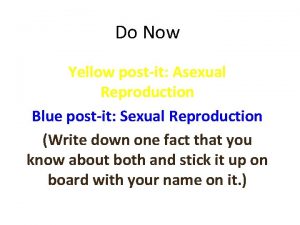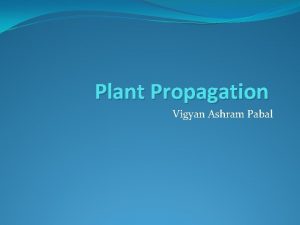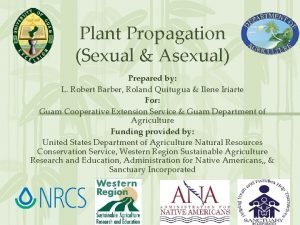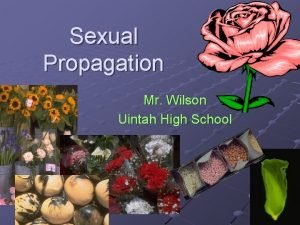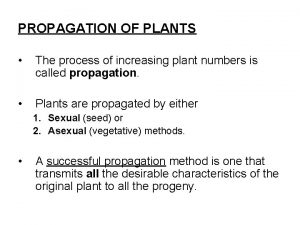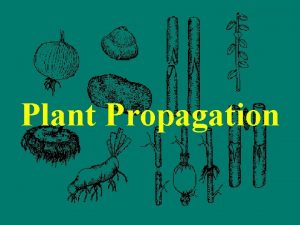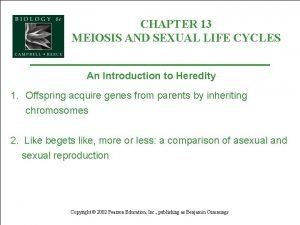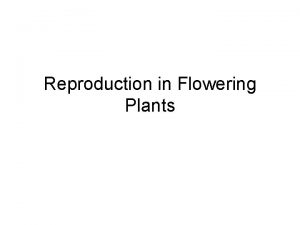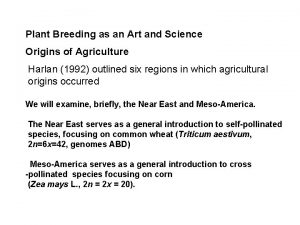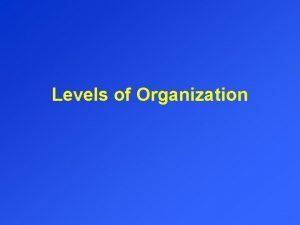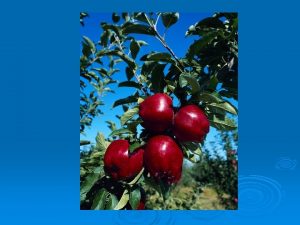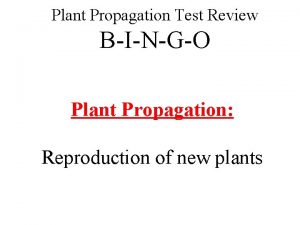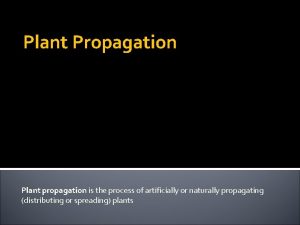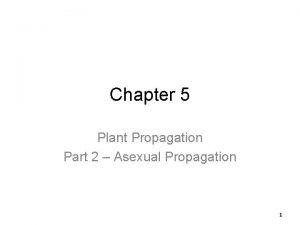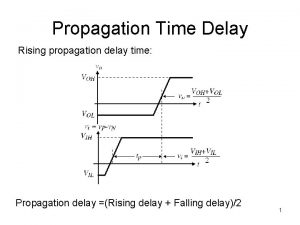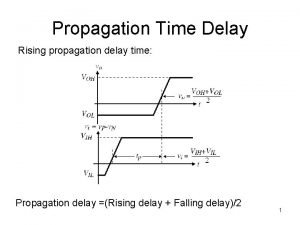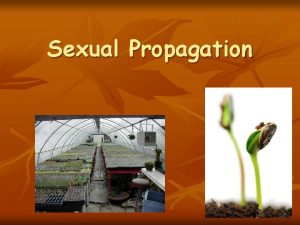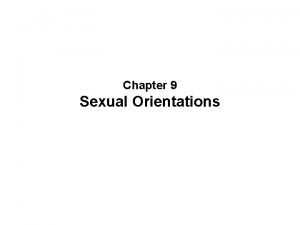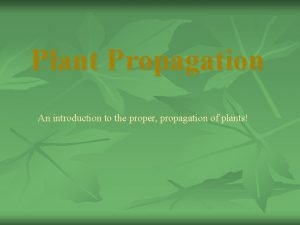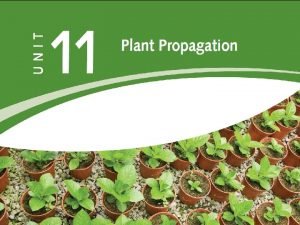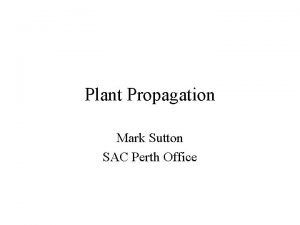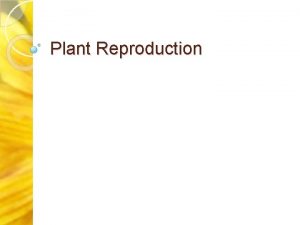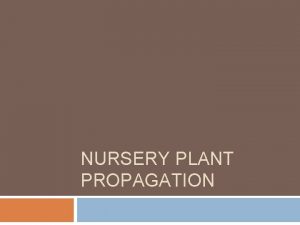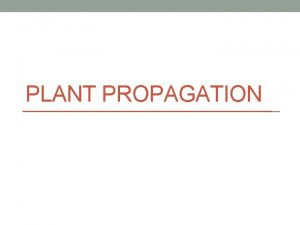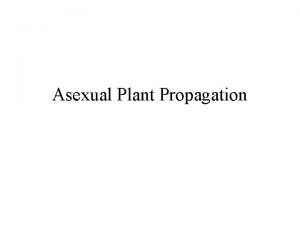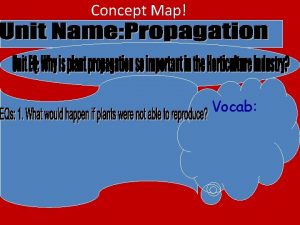Chapter 5 Plant Propagation Part 1 Sexual Propagation





























- Slides: 29

Chapter 5 Plant Propagation Part 1 – Sexual Propagation 1

What is Propagation? • Plant reproduction – Vegetative – Sexual • Sexual vs. Asexual propagation Schefflera cutting Seed of Franklin’s Sandwort 2

Seed Formation • What causes seed formation? – Seeds result from successful pollination and subsequent fertilization – Cross-pollination – Self-pollination • What is hybrid seed? – Technically ‘hybrid’ can apply to any cross-pollinated plant – Term is reserved for plants grown from seed that is the result of special breeding and generally superior 3

Hybrid Seed • Produces seedlings with ‘hybrid vigor’ • Is the result of controlled crossing of a dedicated ‘female line’ and a dedicated ‘male line’ – Both lines are genetically pure will have the best traits of both parents • Seed saved from hybrid plants will not grow into good plants – Only the original hybrid seed will carry the desirable traits 4

Mendelian Genetics • Czech Monk Gregor Mendel, the original founder of the genetic science we have today – Original idea that offspring resemble parents – Studied peas – flower color, seed shape, etc. • Suspected that offspring characteristics are dependent on specific traits that are passed by each parent – These traits are not blended together • Visible manifestation of traits is called ‘phenotype’ 5

Mendelian Genetics • This idea indicates that an offspring may look just like one of the parents, even though it is a product of both parents • Because it is a product of both parents, the genetic composition will not be the same as either parent. • Mendel postulated that traits exist in pairs in each parent – Now called ‘genes’ – And were classified as recessive or dominant depending on if they were manifest in the offspring – Now we understand some genes have ‘partial dominance’ 6

Simplified Mendelian Cross 7

Techniques of Plant Breeding • Plants to be bred must belong to the same genus, and almost always belong to the same species – Cultivars within a species usually cross-pollinate • In rare instances do plants breed across Genera (intergeneric hybrid) – Fatshedera is one example (x. Fatshedera lizei). • One parent is Hedera helix and the other is Fatsia japonica 8

Techniques of Plant Breeding • Cross-pollinated seeds only make up a small percent of seeds produced (estimated around 4%) – The close proximity of the anther and stigma in most flowers tends to promote self-pollination • Dioecious plants can never self-pollinate • How to control the pollination of flowers to be bred depends on the type of flower – Perfect or imperfect 9

Techniques of Plant Breeding • If exact self-pollination is desired, a small bag can be placed over the flower just before it opens (perfect flowers) – When the flower opens it will encounter no other pollen source than from it’s own anthers • For imperfect flowers, pollen must be carefully transferred from the desired male and put on the desired female parent – Often with a small brush – This can also be done with perfect flowers when pollen from another parent is desired instead of allowing it to self-pollinate 10

Hand pollination of watermelon, a monoecious plant 11

Labeling of an eggplant flower after pollination. The flower is taped shut after pollination to prevent contamination of the cross 12

Techniques of Plant Breeding • After successful pollination, the eggs will be fertilized within several days and the floral parts will fall off the flower leaving the enlarging ovary • When seed is mature, it must be removed from the fruit and cleaned for most uses • Storing seeds is best in a sealed bag or jar in a cool, dark environment – Most seeds can be stored for long periods of time – All experience a decrease in germination percentage and seedling vigor as time progresses 13

Wet seed extractor in the field. Used for tomatoes, melons, squash, etc. 14

Three-screen seed cleaner separates seed based on size. Can be used on seeds from dry fruit or seeds from wet fruit after is has been dried. Winnowing or fanning seed with electric fan 15

Direct Seeding • Sowing seeds outdoors is easy and practical • Some basic rules apply to get good germination – Plant in a area suitable for species – light, etc. – Observe proper planting depth (usually a function of seed size) and spacing • 1 ½ times the seed diameter if no other info is available – Ensure seed to soil contact – Keep moist – Thin plants as needed – Fertilize after true leaves appear 16

Sowing seed indoors • A popular practice to extend the growing season – Plants should be started 6 -8 weeks ahead of garden planting – Timing is crucial because if started too early they will grow too long indoors and perform poorly outdoors later 17

Sowing Seeds Indoors • Some basic rules apply – Provide a warm, humid environment – Use a container that will allow water to drain away – Growing medium must be loose, fast-draining, and free from plant pathogens • Commercial potting soils are usually adequate • Commercial soils contain no actual soil – Adequate light must be available • Can be natural, artificial, or a combination of both 18

Some commercial seed-starting kits 19

Commercial seedling production • Large-scale seedling production is often called bedding plant production • Specialized seed sowing equipment, trays, and growing environment • Seedlings can be sold wholesale to other growers for finishing, or transplanted in-house and sold in packs or small pots 20

21

Drum seeder capable of seeding up to 600 trays per hour 22

Damping-off • Whether planted indoors or out, seedlings are susceptible to a number of fungal diseases – When a seedling or group of seedlings is infected with a fungal disease, it is called ‘damping-off’ – It is caused by media that is too wet, excessive humidity, very close plant spacing, and unclean media or environment – The fungus move fast when plants are in high densities as in greenhouses and gardens • Prevented with fungicides, lower humidity, more air circulation, clean and drier media or soil 23

24

Transplanting • The term transplanting can be applied to moving plants from a container into the ground, or from one container to a larger container • Should be done when plants crowd each other or roots are excessively crowded • Seedlings should be handled by leaves and not stem – Can survive a leaf breaking • If roots are very dense, then cutting or separation of the root ball is appropriate 25

Transplanting • Should be done in evening or on a cloudy day to reduce chance of wilting • Root ball should be moist and plants not water -stressed • Shading may be required • Plants should be watered-in immediately after planting to ensure soil-to-root ball contact 26

Hardening-off • Is the term for acclimating seedlings or adjusting them gradually from the greenhouse or growing area to the real world – Idea is to gradually increase light, and wind, decrease humidity, and adjust them to outdoor temperature and conditions – Placing plants outdoors in shade during the day – Placing plants in sunny spot for a few hours a day • After they are hardened they will not appear as soft or succulent, have a stockier stem, and thicker leaves • They are much less likely to wilt and die-back at transplanting outdoors 27

Spores • Ferns produce spores instead of seeds • These spores come from small capsules or spore cases on the bottoms of leaves • Ferns drop their spores on the ground which will grow into a small, flat plant called the ‘prothallus’ • The prothallus then develops the sperm and egg on the underneath side – The sperm swims in the wetness at the forest floor and hopefully some will find the eggs – After successful fertilization a new fern will grow under the prothallus in about a year 28

Spore cases of Grape Fern Split spore cases showing thousands of tiny bead-like spores Prothallus – usually not more that a few centimeters or so in size Pictures from www. hiltonpond. org 29
 Type of sexual reproduction
Type of sexual reproduction Disadvantages of smokeless chulha
Disadvantages of smokeless chulha Example of a sexual propagation
Example of a sexual propagation Simple layering examples
Simple layering examples Advantages of plant propagation
Advantages of plant propagation Plant propagation algorithm
Plant propagation algorithm Introduction in plant breeding
Introduction in plant breeding Plant breeding for disease resistance
Plant breeding for disease resistance Plant introduction in plant breeding
Plant introduction in plant breeding Tronsmo plant pathology and plant diseases download
Tronsmo plant pathology and plant diseases download Tronsmo plant pathology and plant diseases download
Tronsmo plant pathology and plant diseases download Albugo eye
Albugo eye Sexual reproduction
Sexual reproduction Mendelian genetics
Mendelian genetics Chapter 10 sexual reproduction and genetics
Chapter 10 sexual reproduction and genetics Metaphase ii
Metaphase ii Chapter 13 meiosis and sexual life cycles
Chapter 13 meiosis and sexual life cycles Plants have male and female parts
Plants have male and female parts Plant breeding as an art
Plant breeding as an art What part of the flower makes pollen
What part of the flower makes pollen Function of a plant
Function of a plant Things that have roots
Things that have roots Levels of organization nonliving
Levels of organization nonliving Addition symbol
Addition symbol Part to part ratio definition
Part to part ratio definition Part part whole
Part part whole What is technical description
What is technical description Parts
Parts The part of a shadow surrounding the darkest part
The part of a shadow surrounding the darkest part 미니탭 gage r&r 해석
미니탭 gage r&r 해석
